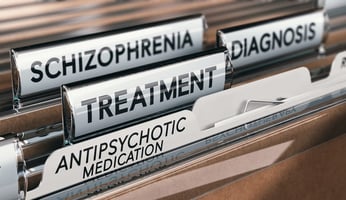Meta-Analysis Identifies Effective Doses and Dose Equivalents for 20 Antipsychotics
 |
“The dose-response relationships of antipsychotic drugs for the acute treatment of schizophrenia are not well understood, but further defining them would be important for many reasons,” wrote Stefan Leucht, M.D., of the Technical University of Munich and colleagues. “Clinicians need to know the minimum effective doses and the maximum effective doses when they prescribe antipsychotics, and guidelines attempt to provide such information.”
Leucht and colleagues compiled data from 68 clinical studies that compared multiple doses of antipsychotics in people with acute schizophrenia symptoms. Using those data, they developed dose-response curves for the following medications: amisulpride, aripiprazole (oral and LAI), asenapine, brexpiprazole, cariprazine, clozapine, haloperidol, iloperidone, lurasidone, olanzapine (oral and LAI), paliperidone (oral and LAI), quetiapine, risperidone (oral and LAI), sertindole, and ziprasidone.
The dose-response graphs for many of the antipsychotics indicated that the optimal dose is likely less than the maximum approved dose. For example, the most effective doses of oral aripiprazole and risperidone were calculated at 11.5 mg/day and 6.3 mg/day, well below their top approved doses of 30 mg/day 16 mg/day, respectively. For such medications, raising the dose may not necessarily provide better symptom improvement, the authors noted.
For other medications such as lurasidone and oral olanzapine, the dose-response curve had not yet plateaued at the highest doses tested (160 mg/day and 15 mg/day respectively), suggesting the optimal dose may not have been identified yet. Leucht and colleagues believe that further clinical studies on dosing are warranted to see if these medications could be more effective.
“We stress that our results provide some guidance based on ‘average’ patients with chronic illness,” the authors concluded. “Individual dosing decisions should be guided by the properties of each drug (e.g., pharmacodynamic and pharmacokinetic properties, side effects), patient characteristics (e.g., age, illness stage, severity, physical comorbidities, and previously known individual effective doses), and concomitant treatments that could, by interaction, influence drug plasma levels.”
For more information, the authors provided an Excel spreadsheet with a dose conversion table and calculators.
To read more on this topic, see the American Journal of Psychiatry article, “Sixty Years of Placebo-Controlled Antipsychotic Drug Trials in Acute Schizophrenia: Systematic Review, Bayesian Meta-Analysis, and Meta-Regression of Efficacy Predictors.”
(Image: iStock/Dmitrii_Guzhanin)
Follow Psychiatric News on Twitter!
And check out the new Psychiatric News Brief on Alexa-enabled devices.
And check out the new Psychiatric News Brief on Alexa-enabled devices.





